Black snakes are found almost everywhere in the world — Arizona is no exception. This state is well-known to be home to about 55 species of snakes. Of these various species, some of them are black in color. Most people can’t correctly identify or differentiate black snakes from each other. Not entirely their fault — these snakes are mostly black, except for their chin and belly which may come in any color. Despite this, you should be aware that all black snakes, irrespective of their species, are incredibly unique! They have different distinctive features, sizes, habitats, behavior, and diets.
Interestingly, people assume that black snakes are deadlier than other snakes, because of their appearance. Contrary to this belief, most black snakes are non-venomous and non-aggressive, only biting as a last resort when feeling threatened. This is why they have even become popular pets amongst collectors and are used by farmers as pest control since they eat rodents and other pest animals. Note that a few, such as the Arizona black rattlesnake, are however venomous.
So, this article will help you identify the 7 most common species of black snakes you’ll likely encounter in Arizona.
Common Kingsnake (Lampropeltis getula)
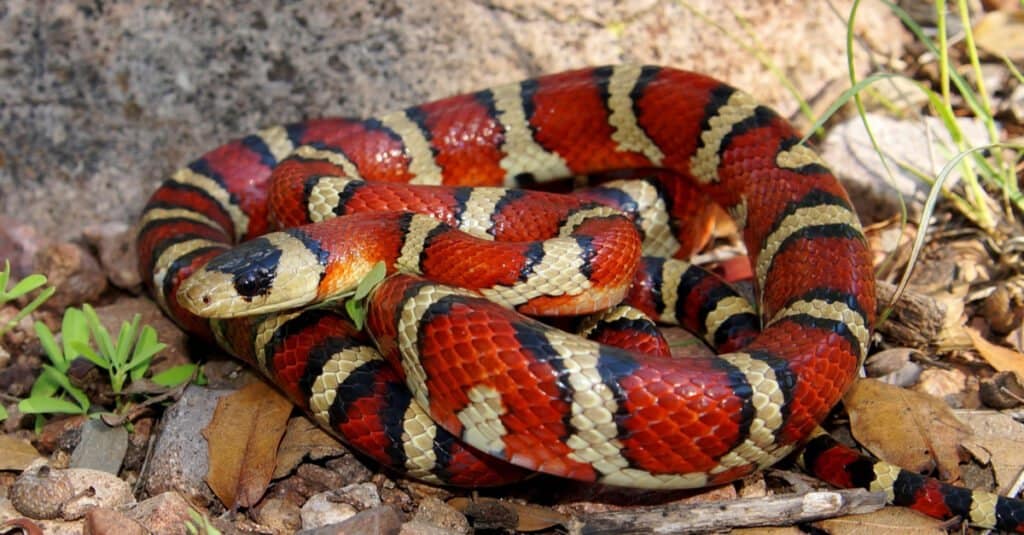
Kingsnakes are non-aggressive and remain docile even when caught.
©Matt Jeppson/Shutterstock.com
Slender, glossy black with yellow or white bands around its body, the common kingsnake in Arizona measures about 3 ¼ feet in length. However, the color patterns of this snake may vary across the range. In some parts of Arizona (southern Arizona), it is completely black with no colored bands, while in others the bands appear thinner. Common kingsnakes are found all over the United States, with most species preferring open areas and riparian zones.
Their diet consists of lizards, rodents, birds, bird eggs, and turtle eggs. They also eat other snakes, including venomous snakes like copperheads and rattlesnakes, mainly because they’re immune to these snakes’ venom. In turn, they are preyed on by large vertebrates like eagles, falcons, hawks, and other birds of prey. The common kingsnake is considerably non-aggressive, remaining docile even when caught, making this species a favorite among snake collectors.
Arizona Black Rattlesnake (Crotalus cerberus)
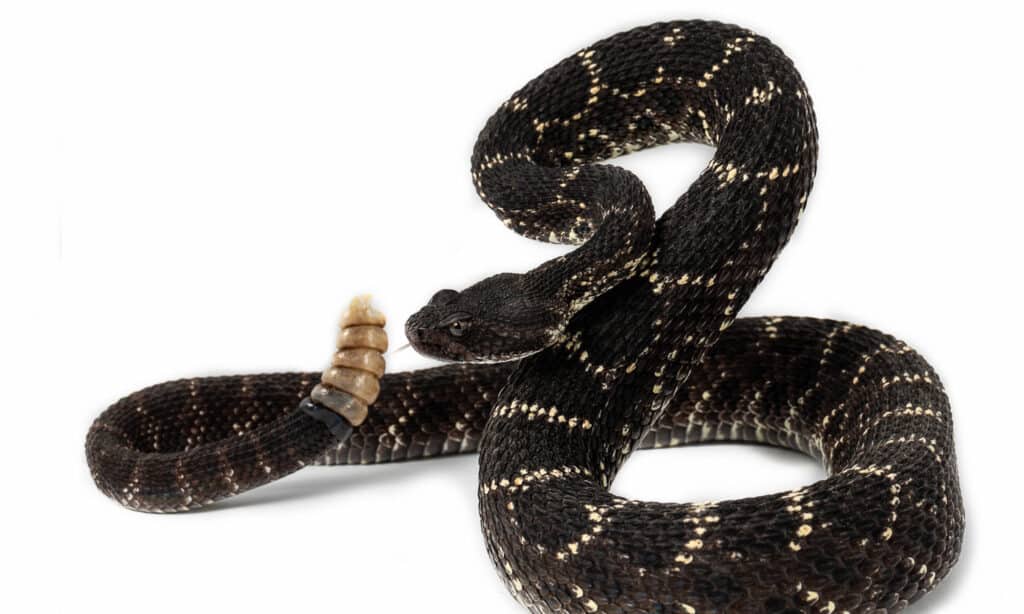
Arizona black rattlesnakes have highly toxic venom.
©Scott Delony/Shutterstock.com
Medium-sized, heavy-bodied, and predominantly black, the Arizona black rattlesnake is a venomous pit viper species occurring in the southwestern United States. Easily mistaken for other large rattlesnakes in Arizona, they are distinguished by their black, dark grey bodies with several dark blotches which morph into dark bands on the tail. Juveniles are lighter-colored and have prominent spots on their head. In addition, some C. Cerberus species have a unique ability to change their color under certain conditions, similar to chameleons. The Arizona black rattlesnake feeds on reptiles, small mammals, amphibians, birds, and bird eggs. They are also found near water sources and in riparian areas, as well as places with abundant woody debris and leaf litter. Even though their venom is highly toxic, most individuals of this species are relatively docile compared to other rattlesnakes in Arizona.
Brahminy Blindsnake (Indotyphlops braminus)

Brahminy blindsnakes are endemic to
Africa
and Asia.
©Radiant Reptilia/Shutterstock.com
With tiny eyes covered by translucent scales rendering them almost completely blind, these black snakes were a recent introduction to Arizona and are originally native to Africa and Asia. Often mistaken for earthworms, Brahminy blindsnakes are tiny, worm-like snakes with glossy black, dark grey, or dark brown dorsum with rows of dorsal scales along their body. Adult blindsnakes measure about 2-6 inches long, making them the smallest known snake species, after the Barbados thread snake. They are usually found underground near ant and termite nests, where they feed on larvae, eggs, and pupae of these insects.
Blindsnakes are typically found in urban areas and moist habitats in Arizona, probably because this species is prone to desiccation. They are nicknamed “flowerpot snakes” because they tend to be moved to various parts of the world in the soil of potted plants through plant trade. The brahminy blindsnake is considered the most widely distributed terrestrial reptile.
Black Coachwhip (Masticophis flagellum)
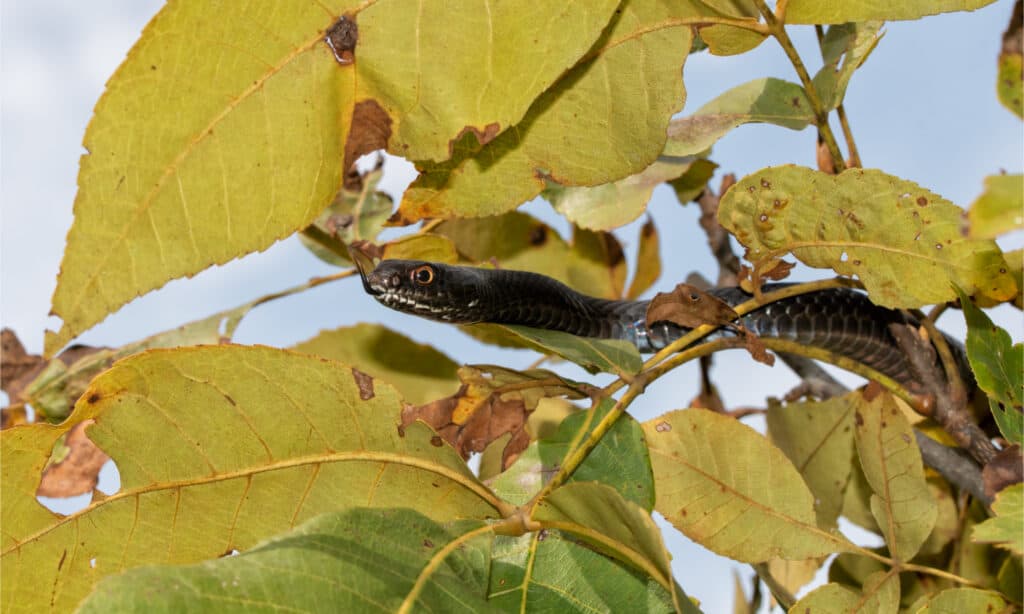
Coachwhip snakes are present in a variety of habitats in the U.S.
©Sari ONeal/Shutterstock.com
Coachwhip snakes are slender, harmless, fast-moving snakes found throughout the southern United States. They are often black, tan, or grey, with small heads and large eyes. Their scales are patterned, so the snake appears braided at first glance — resembling the whip used by stagecoach drivers, hence its name. They occur in a variety of habitats, including open areas, grasslands, and even cultivated lands. Coachwhips prey on reptiles, small birds, and rodents. They are nervous snakes, usually seen retreating into rocks or burrows when threatened. They are also known to cover long distances while being extremely fast, traveling up to 4 miles per hour!
Black Racer (Coluber constrictor)
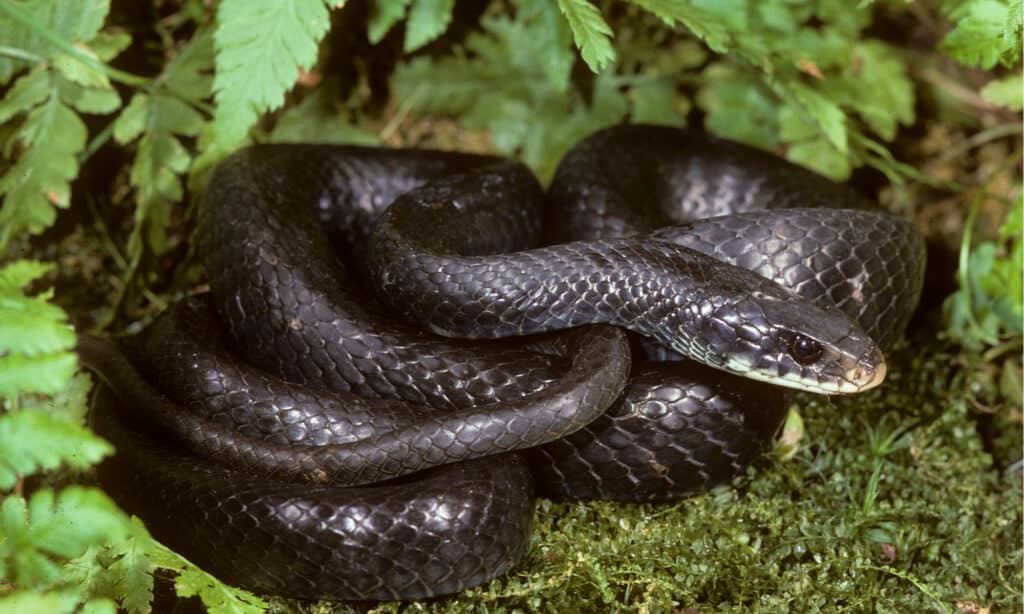
Black racers spend most of their time on the ground.
©Breck P. Kent/Shutterstock.com
Also called the Eastern racer, this black snake is found throughout the United States, especially in North America and Central America. The color pattern varies widely among several subspecies of racers. Most are black, brown, blue, tan, or pink – similarly named according to their color. They all have lighter-colored underbelly and juveniles are more strikingly patterned than adults. The black racer made it to our list because of its solid black color, unlike its differently colored cousins. Adult black racers measure about 20 to 60 inches in total length and weigh about 1.226 lb. This snake species is usually found near water and in grasslands, light forests, swamps, and suburbia. Even though it spends most of its time on the ground, it usually climbs trees to raid bird nests for eggs and also prey on small birds like canaries and finches.
Desert Kingsnake (Lampropeltis splendida)
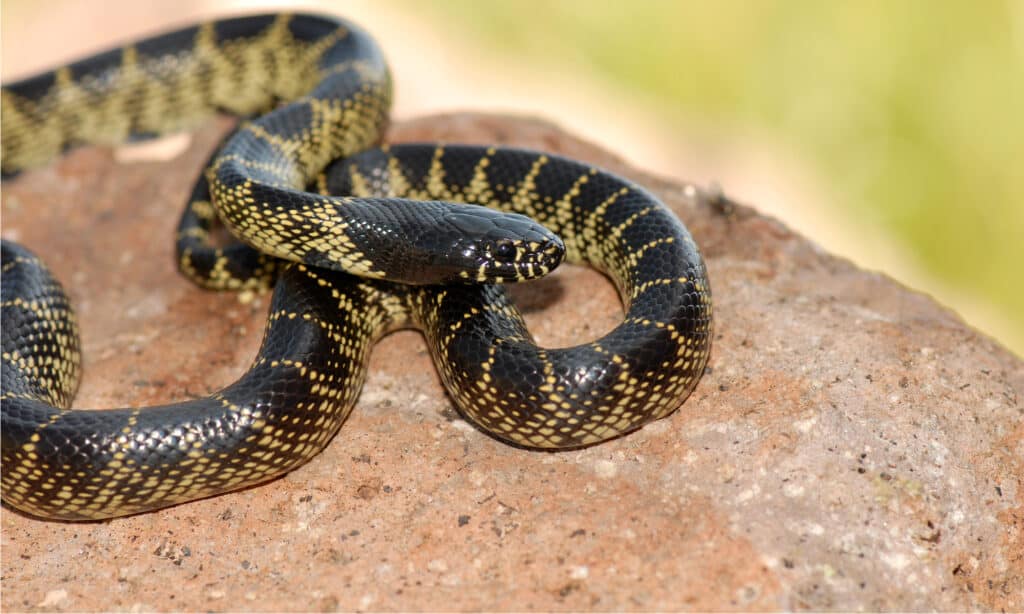
Desert kingsnakes are nonvenomous snakes that play dead when confronted by humans.
©Rusty Dodson/Shutterstock.com
This is a non-venomous species of kingsnake native to Arizona, and other states like Texas and New Mexico. The desert kingsnake’s dorsum is black or dark brown with yellow or off-white blotches. Both adult and juvenile snakes have black abdomen, also with white or pale yellow blotches marking the outer ends. Contrary to what its name may suggest, this snake is found in wet areas, especially near water tanks or within riparian corridors. It is a powerful constrictor whose primary diet is mice and other rodents. Because of its resistance to pit viper venom, it is also able to feed on small snakes within its range such as young diamondback rattlesnakes. However, kingsnakes are docile creatures when confronted by humans and they often ‘play dead’ by flipping over on their backs and lying motionless.
Ring-necked snake (Diadophis punctatus)
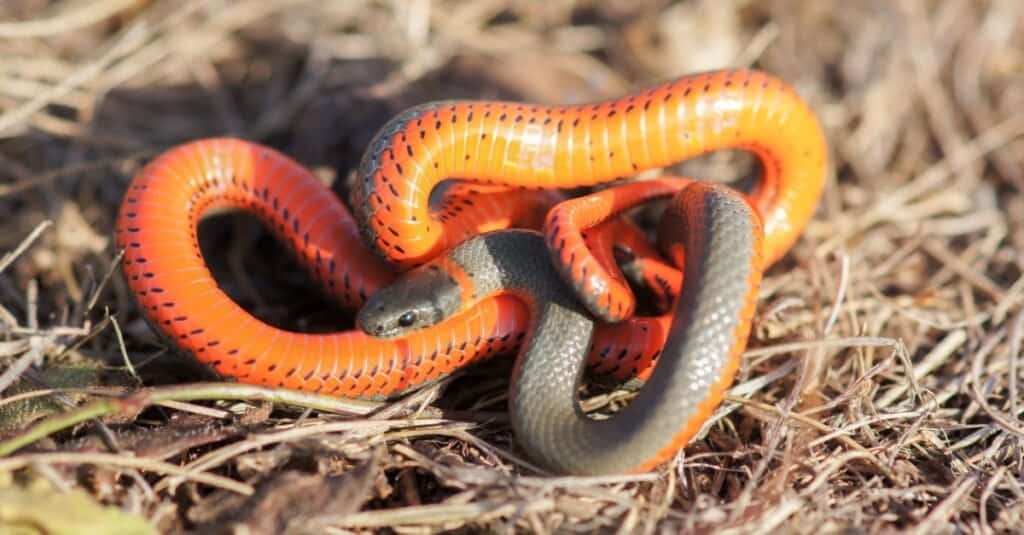
The ring-necked snake is nocturnal and non-venomous.
©yhelfman/Shutterstock.com
Measuring 10-15 inches in length, the ring-necked snake is a small, harmless species of snake found throughout the United States. They are distinguished by their smoky-black to bluish-grey dorsal body and a yellow, red, or yellow-orange neckband. A few individuals may have reduced or partially colored neckbands while some do not have the distinctive neckbands at all. Ring-necked snakes are secretive, nocturnal snakes rarely seen during the day. When threatened, they assume a defensive posture – they curl up their tails and expose their bright red-orange ventral surface and release a foul-smelling odor. Their diet consists of salamanders, earthworms, slugs, lizards, frogs, and juvenile snakes of other species.
Other Rattlesnakes Found in Arizona

The western diamondback rattlesnake is one of the many rattlesnake species found in Arizona.
©Alexander Wong/Shutterstock.com
The Arizona black rattlesnake is far from the only rattlesnake that is present in the state. In fact, Arizona has the largest number of rattlesnakes in the Unites States! There are at least 15 types of rattlesnakes in total found across the state. Four rattlesnake species are protected by state law, and a license is required to hunt other types.
As these snakes prefer to avoid human contact, it’s thought that 60-70% of rattlesnake bites in Arizona are due to people attempting to move, capture, or provoke one of these venomous snakes.
The other rattlesnake species that are found in Arizona are: the western diamondback rattlesnake, Mojave rattlesnake, speckled rattlesnake, northern black-tailed rattlesnake, desert Massasauga, tiger rattlesnake, sidewinder rattlesnake, Arizona ridge-nosed rattlesnake, New Mexico ridge-nosed rattlesnake, banded rock rattlesnake, twin-spotted rattlesnake, Great Basin rattlesnake, Grand Canyon rattlesnake, and prairie rattlesnake. Read more about all of these rattlesnakes here.
The photo featured at the top of this post is © iStock.com/Murilo Gualda
Discover the "Monster" Snake 5X Bigger than an Anaconda
Every day A-Z Animals sends out some of the most incredible facts in the world from our free newsletter. Want to discover the 10 most beautiful snakes in the world, a "snake island" where you're never more than 3 feet from danger, or a "monster" snake 5X larger than an anaconda? Then sign up right now and you'll start receiving our daily newsletter absolutely free.
Thank you for reading! Have some feedback for us? Contact the AZ Animals editorial team.







